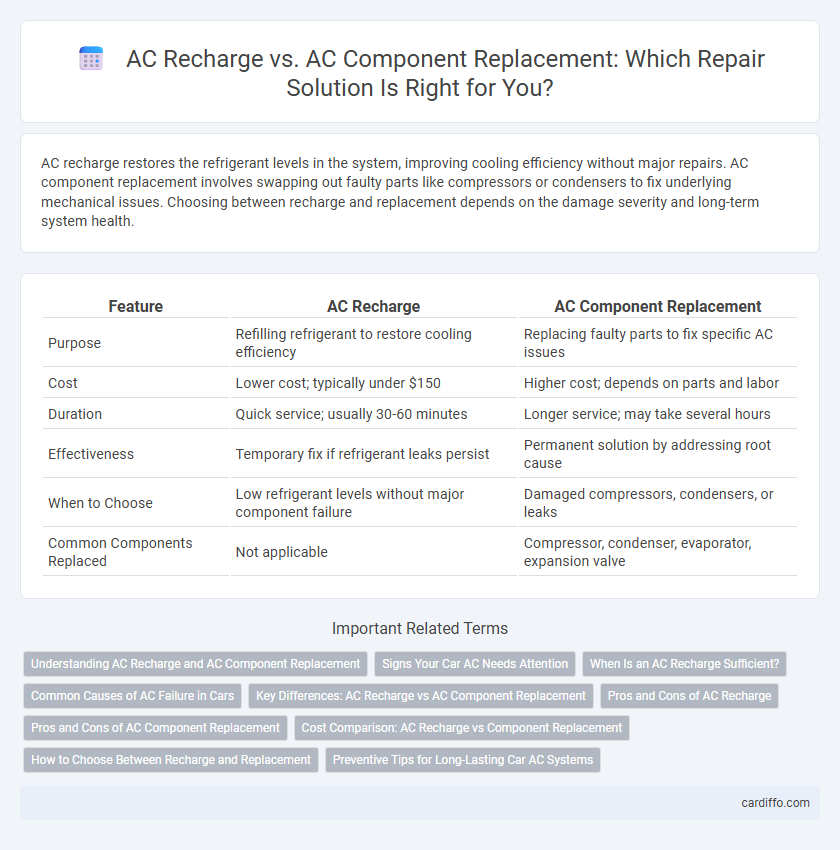AC recharge restores the refrigerant levels in the system, improving cooling efficiency without major repairs. AC component replacement involves swapping out faulty parts like compressors or condensers to fix underlying mechanical issues. Choosing between recharge and replacement depends on the damage severity and long-term system health.
Table of Comparison
| Feature | AC Recharge | AC Component Replacement |
|---|---|---|
| Purpose | Refilling refrigerant to restore cooling efficiency | Replacing faulty parts to fix specific AC issues |
| Cost | Lower cost; typically under $150 | Higher cost; depends on parts and labor |
| Duration | Quick service; usually 30-60 minutes | Longer service; may take several hours |
| Effectiveness | Temporary fix if refrigerant leaks persist | Permanent solution by addressing root cause |
| When to Choose | Low refrigerant levels without major component failure | Damaged compressors, condensers, or leaks |
| Common Components Replaced | Not applicable | Compressor, condenser, evaporator, expansion valve |
Understanding AC Recharge and AC Component Replacement
AC recharge involves replenishing the refrigerant in an air conditioning system to restore cooling efficiency, typically performed when refrigerant levels are low due to minor leaks or evaporation. AC component replacement addresses more significant issues by swapping out faulty parts such as compressors, condensers, or evaporators, which directly impact overall system functionality. Understanding these distinctions helps diagnose whether a simple recharge or a full component replacement is necessary for optimal HVAC performance.
Signs Your Car AC Needs Attention
Signs your car AC needs attention include diminished cooling performance, unusual odors, and strange noises when the AC is running. Low refrigerant levels often indicate a leak requiring an AC recharge, while damaged components such as the compressor or condenser typically demand AC component replacement. Regular maintenance can prevent costly repairs by addressing issues like refrigerant loss and worn-out parts promptly.
When Is an AC Recharge Sufficient?
An AC recharge is sufficient when the system has a low refrigerant charge without any leaks, typically indicated by reduced cooling efficiency and short cycling. It restores optimal performance by replenishing refrigerant levels, extending the lifespan of components like the compressor and condenser. If leaks or mechanical failures are present, replacing components is necessary to ensure long-term system reliability.
Common Causes of AC Failure in Cars
Common causes of AC failure in cars include refrigerant leaks, compressor malfunction, and clogged or damaged condenser coils. Recharging the AC system addresses low refrigerant levels but does not fix underlying mechanical or component issues such as a faulty compressor or electrical faults. Component replacement is necessary for damaged parts like the compressor, condenser, or evaporator to restore proper cooling function and prevent recurring failures.
Key Differences: AC Recharge vs AC Component Replacement
AC recharge involves refilling the refrigerant to restore cooling efficiency in an air conditioning system, typically addressing low refrigerant levels due to minor leaks or evaporation. AC component replacement targets specific parts such as compressors, condensers, or evaporators that have malfunctioned or failed, requiring a more extensive repair to ensure system functionality. Understanding these key differences helps determine whether a simple recharge or a complex part replacement is necessary for effective AC repair.
Pros and Cons of AC Recharge
AC recharge restores the refrigerant level, improving cooling efficiency without the high cost of component replacement. It offers a quick, cost-effective fix but may only be a temporary solution if there are underlying leaks or damaged parts. Frequent recharges can drain resources and mask deeper mechanical issues requiring comprehensive repairs.
Pros and Cons of AC Component Replacement
AC component replacement offers a long-term solution by restoring the system to optimal functionality, potentially preventing frequent breakdowns associated with patch repairs. However, it can be significantly more expensive and time-consuming than an AC recharge, requiring professional diagnosis and part sourcing. While replacement ensures durability and reliability, it may not be necessary if the system only suffers from minor coolant depletion.
Cost Comparison: AC Recharge vs Component Replacement
AC recharge typically costs between $100 and $200, offering a more affordable short-term solution for restoring cooling efficiency, whereas AC component replacement, such as compressor or condenser repair, can range from $500 to $1,500 depending on the part and vehicle model. Recharging the AC system addresses refrigerant loss but does not fix underlying mechanical failures that require component replacement, which incurs higher labor and parts costs. Choosing between recharge and replacement depends on the extent of damage, with recharge providing cost savings for minor leaks and replacement necessary for severe system component failures.
How to Choose Between Recharge and Replacement
Choosing between an AC recharge and AC component replacement depends on diagnosing the system's condition and the presence of leaks or damaged parts. If the AC system only requires refrigerant to restore cooling efficiency and shows no leaks, a recharge is a cost-effective solution. However, persistent issues like compressor failure, condenser damage, or severe component wear necessitate replacement to ensure long-term functionality and prevent recurrent problems.
Preventive Tips for Long-Lasting Car AC Systems
Regularly recharging your car AC system with the correct refrigerant level maintains optimal cooling efficiency and prevents compressor strain, while timely replacement of faulty components like the condenser, evaporator, or compressor ensures system integrity and avoids extensive damage. Routine inspections for leaks, clogged filters, and worn-out belts help extend the lifespan of your AC system by addressing minor issues before they escalate. Adhering to manufacturer-recommended maintenance schedules and using genuine replacement parts significantly improves the durability and performance of car AC systems.
AC recharge vs AC component replacement Infographic

 cardiffo.com
cardiffo.com